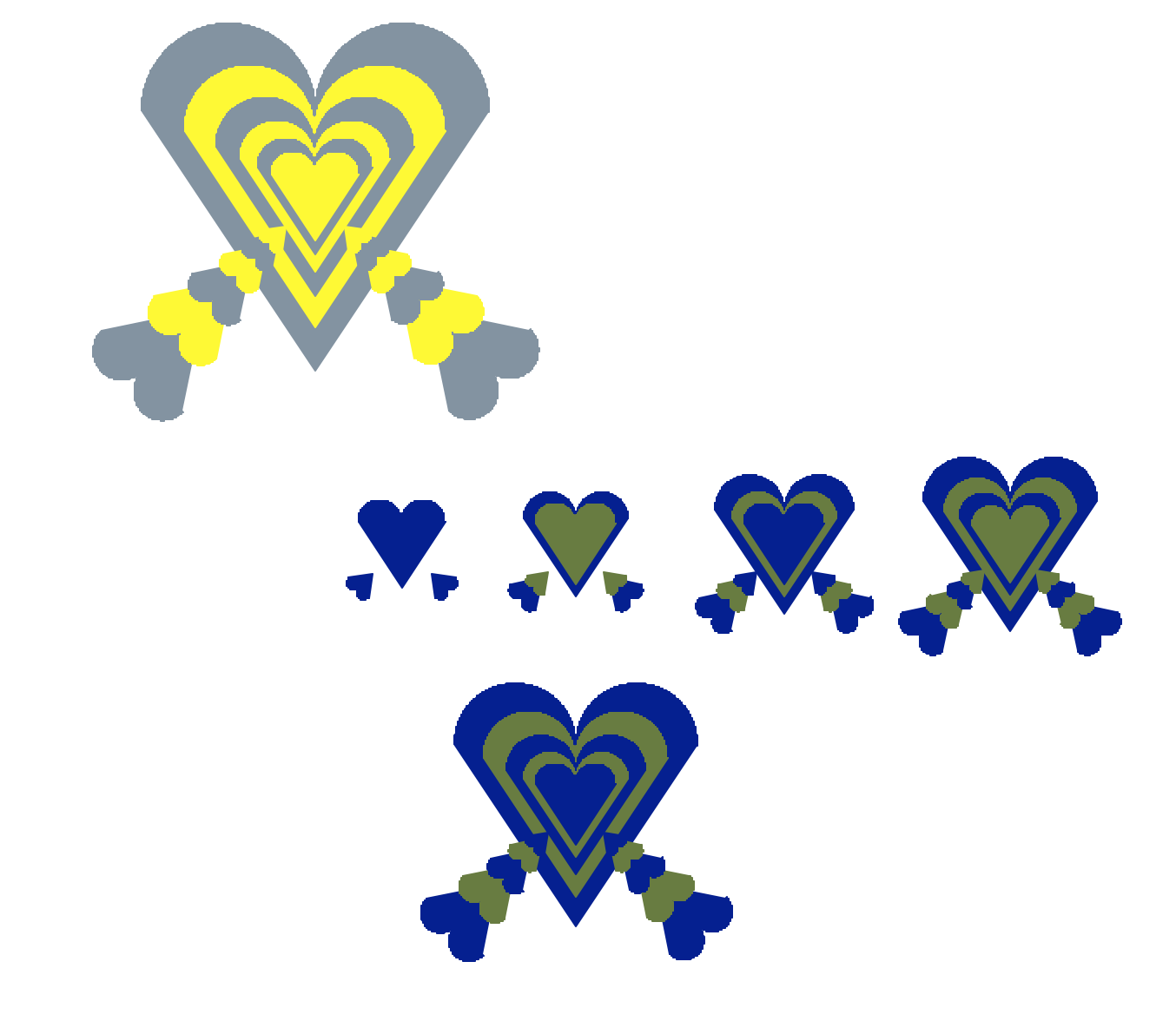Our plan for today
- sumUpTo
- exponents
- fruitful recursion with lists of strings
- fruitful recursive hearts in cs1graphics (because we love python!)
- fruitful recursive turtle graphics
lab7_programs folder from the cs111d download directory.
Rename it so it contains your name, and save all your files from today's lab in that folder.
In today's lab, you'll practice writing fruitful recursive functions. We will start with numbers and lists, and then move to cs1graphics and turtles.
We'll produce cool patterns using cs1graphics and also in TurtleWorld.
Remember that your cs1graphics files will need
from cs1graphics import *For your turtle world code, you can use
turtles.py in
the lab7_programs folder as a template to get you started
(you won't need this until Task 4).
Task 0: Fruitful recursion: sumUpTo Create
a new file in your lab7_programs folder and name it
something descriptive (e.g. lab7.py). In this new file, create a fruitful recursive
function called
sumUpTo(num) that will return the sum of all numbers up to and including the given number.
For example,
sumUpTo(0) returns 0
sumUpTo(3) returns 6 (because 3 + 2 + 1 = 6)
sumUpTo(10) returns 55
sumUpTo(88) returns 3916
sumUpTo(500) returns 125250
sumUpTo(1000) returns "RuntimeError: maximum recursion depth exceeded"
Make sure that your function actually returns a value (as opposed to merely printing it). Here's a way to test it. If a line in your lab7.py file says this:
print sumUpTo(10)That should produce the number 55. If it produces "None", then your function prints rather than returns the value. Task 1: Fruitful recursion: exponents In your
lab7.py file, create a fruitful recursive
function called
exp(base,power) that will return basepower.
For example,
exp(6,0) ==> 1 exp(2,5) ==> 32 exp(9,2) ==> 81 exp(5,11) ==> 48828125 exp(4,-2) ==> This function handles positive exponents onlyTask 2: Fruitful recursion: String lists Write a function called
mapO that takes a list of strings, and returns a list of strings with an 'o' added to the end of each string.
Here are some examples:
print mapO(['hell','cheeri','JL','ore']) print mapO([]) print mapO(['No','Yes','Maybe']) print mapO(['Robert','Carl','Leonard','Rome','Valentin'])produces
['hello', 'cheerio', 'JLo', 'oreo'] [] ['Noo', 'Yeso', 'Maybeo'] ['Roberto', 'Carlo', 'Leonardo', 'Romeo', 'Valentino']Task 3: Fruitful recursion: Dropping R words Write a function called
dropRs that takes a list of
strings, and returns a list where all the strings starting with the letter 'r' have been removed.
print dropRs(['snow','rain','sleet','turtles']) print dropRs(['Swim','Bike','Run']) print dropRs(['lather','rinse','repeat']) print dropRs(['read','write','rithmetic']) print dropRs(['red','room','really'])produces
['snow', 'sleet', 'turtles'] ['Swim', 'Bike'] ['lather'] ['write'] []Task 4: Fruitful recursion with cs1graphics We have used the
cs1graphics package a lot in this
course, but this is the first time we will write fruitful recursive
functions using cs1graphics. The key is that our fruitful
recursive functions will return a layer, and that
layer will contain the object to be drawn on
the cs1graphics canvas.
In your lab7_programs folder, there is a file
called hearts.py. Inside this file is a function
called makeHeart(size,color) that creates and returns a
layer with a heart shape with the given size and color.
Note that size is the radius of the semicircles
on top of the heart.
Here are some
sample invocations of makeHeart(size,color):
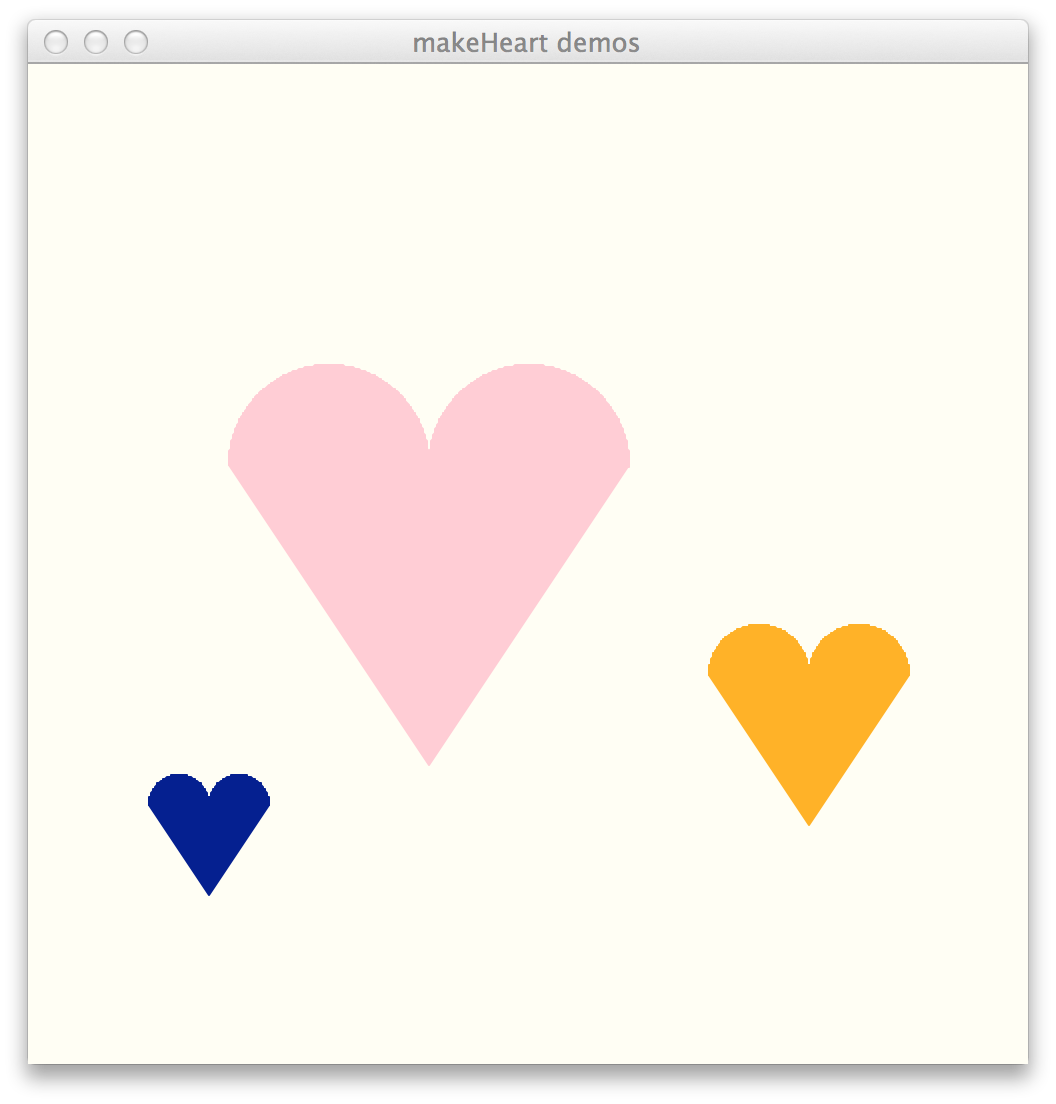 |
paper0 = Canvas(500,500,'ivory','makeHeart demos') h1 = makeHeart(100,'pink') h1.moveTo(200,200) paper0.add(h1) h2 = makeHeart(50,'orange') h2.moveTo(390,305) paper0.add(h2) h3 = makeHeart(30,'navy') h3.moveTo(90,370) paper0.add(h3) |
Note how first the
makeHeart() function is called, and then the
resulting layer is assigned to a variable
(e.g. h1, h2 or h3 in the code
above). Let's consider the variable h1. See
how h1 is moved toward the center of the canvas (200,200) (the exact center would be (250,250))?
This is important. If we executed this code (without the move),
this is what we would see:
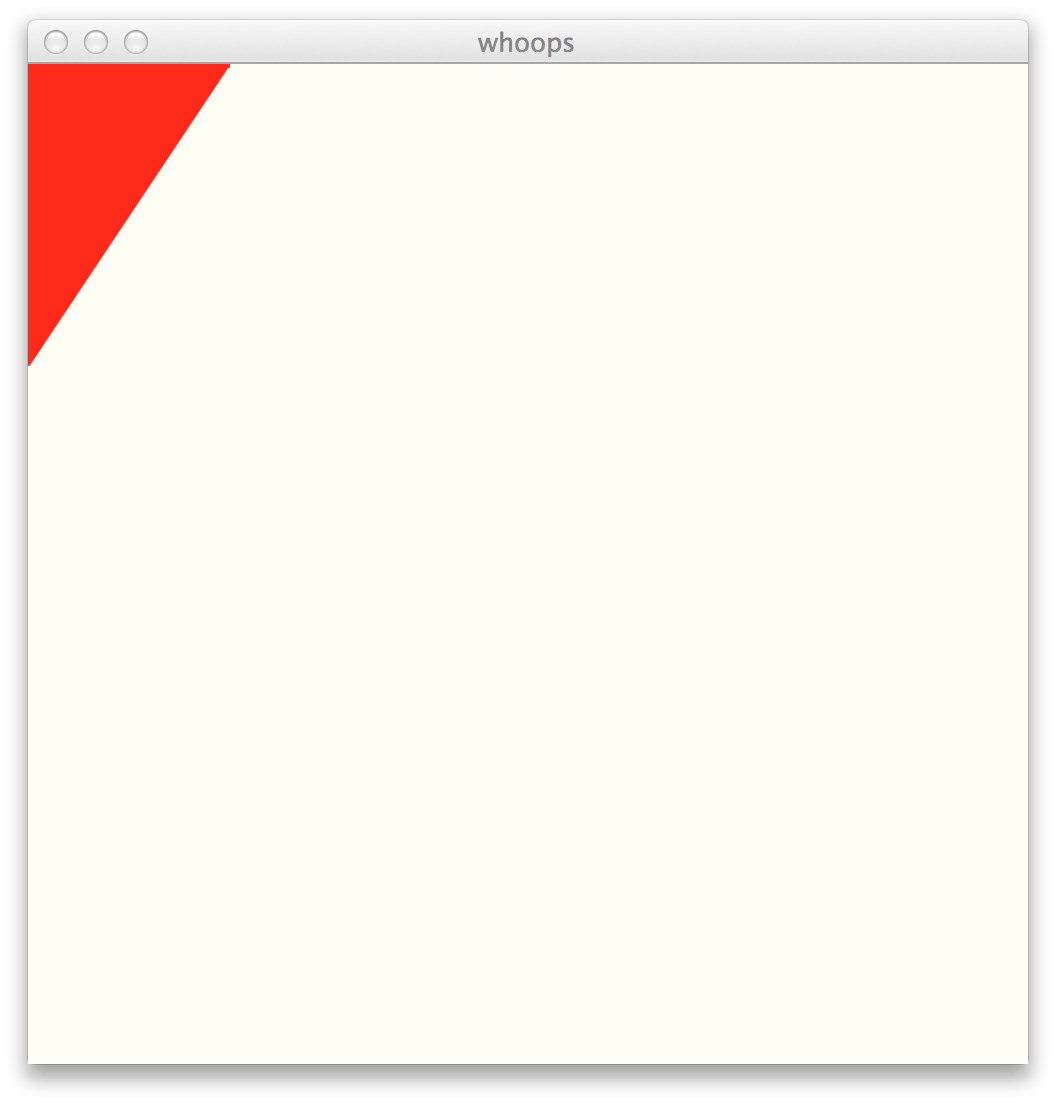
|
paper = Canvas(500,500,'ivory','whoops') h1 = makeHeart(100,'red') paper.add(h1) |
Why? Because the
makeHeart() function
returns a layer that contains a heart that is centered around
the Point(0,0), the default center point for
all cs1graphics objects. If we do NOT move the layer,
then it remains in the original position, which is why we can only
see the lower right hand side of the heart.
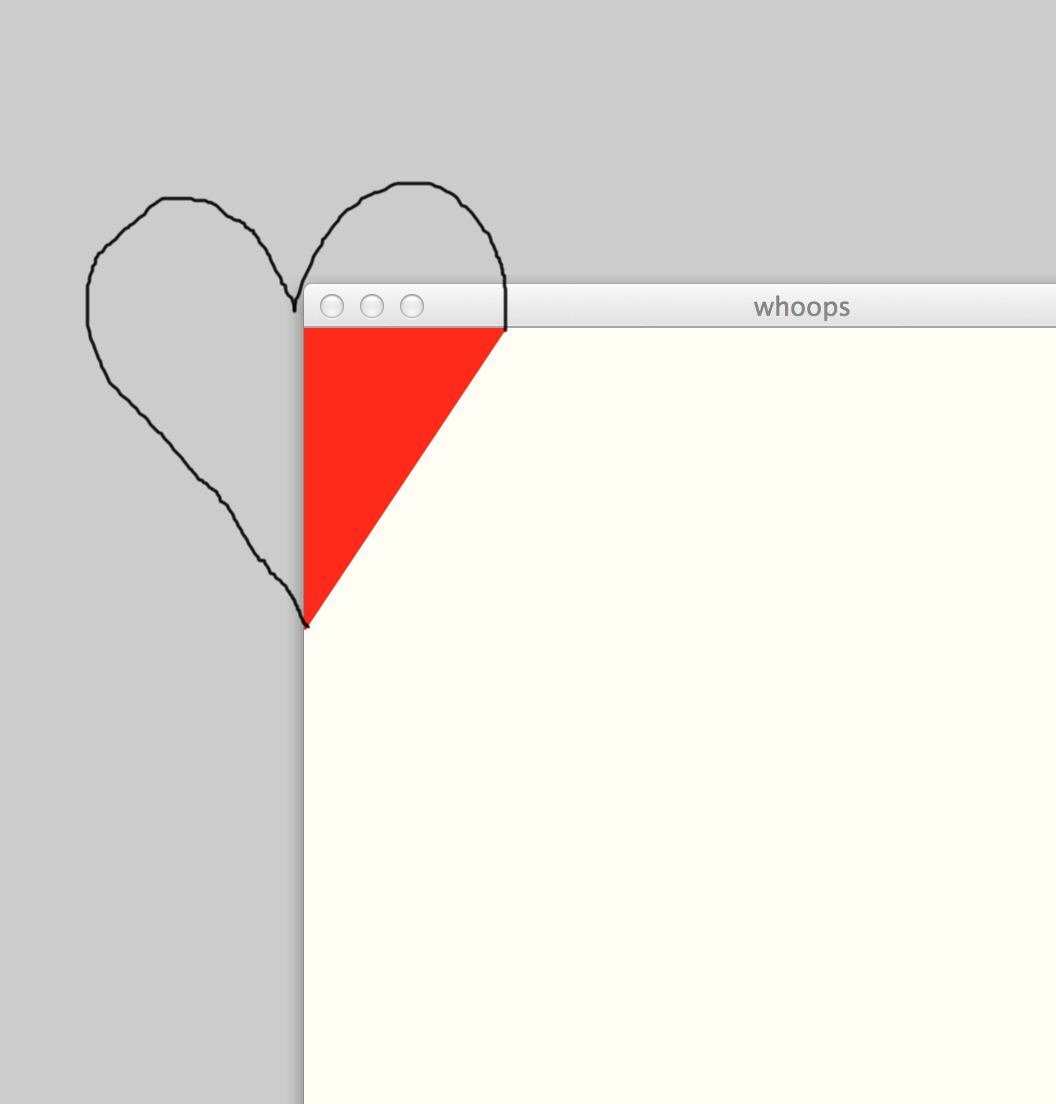
Task 4a: return a row of hearts recursively
Write a function called heartRow(number,size,color) that
returns a row of number hearts that have
size size and are color color. In this
function, it is the number of hearts that controls the recursion. For
example, heartRow(0,10,'red') would not produce any
hearts. Note that heartRow() is fruitful in that
it returns a row of hearts. We'll use this function in the next task.
Below are some sample invocations of heartRow(number,size,color)
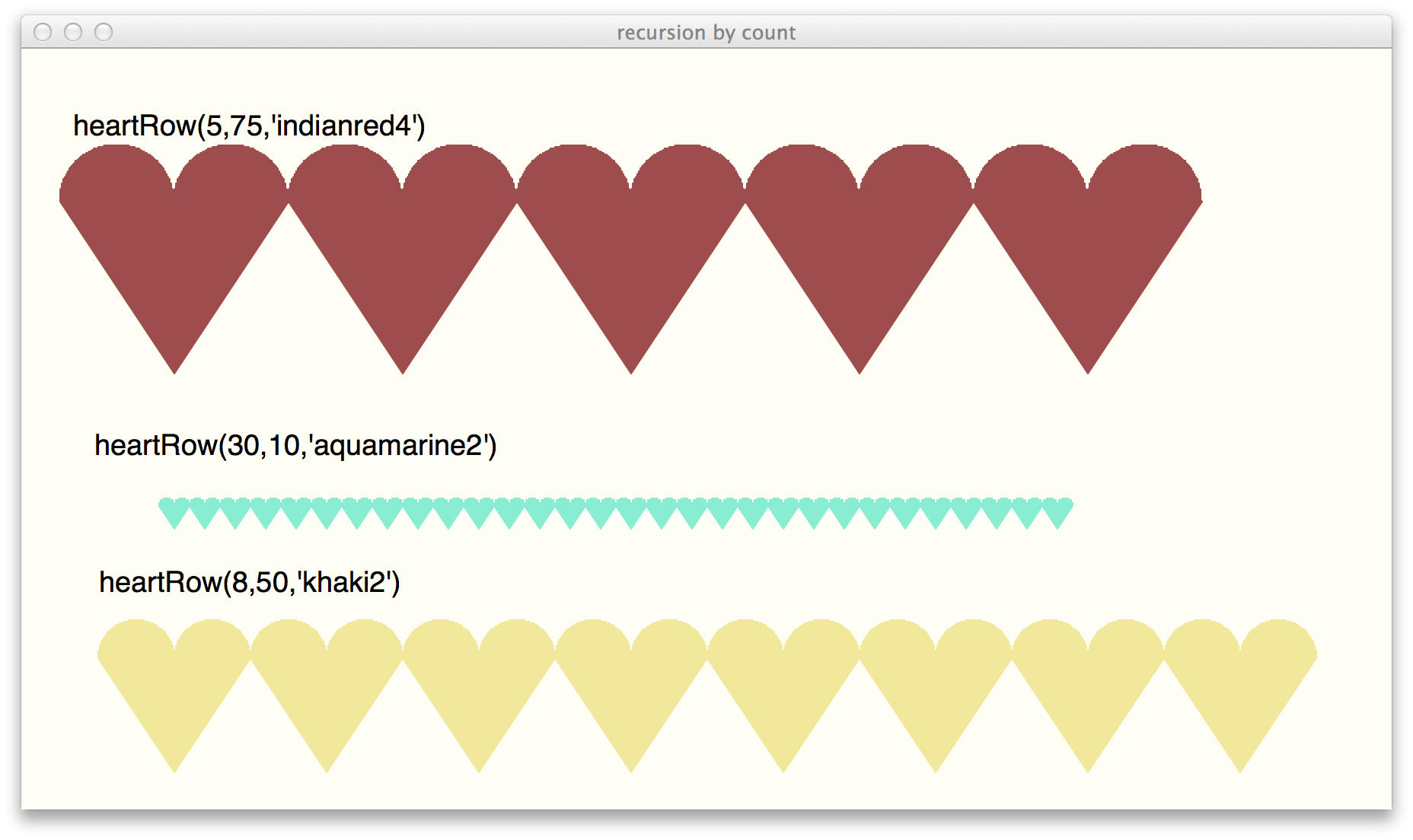
Task 4a extra: return a "star" of rows of hearts
For this task, assume that each of the 8 "petals" will be separated by 45 degrees.
You should call heartRow() to generate the rows of hearts, and then
add each row to the Layer that starBurst returns.
Below are some sample invocations of starBurst(numPetals,number,size,color)
starBurst(8,10,15,'red')

starBurst(8,3,40,'orange')
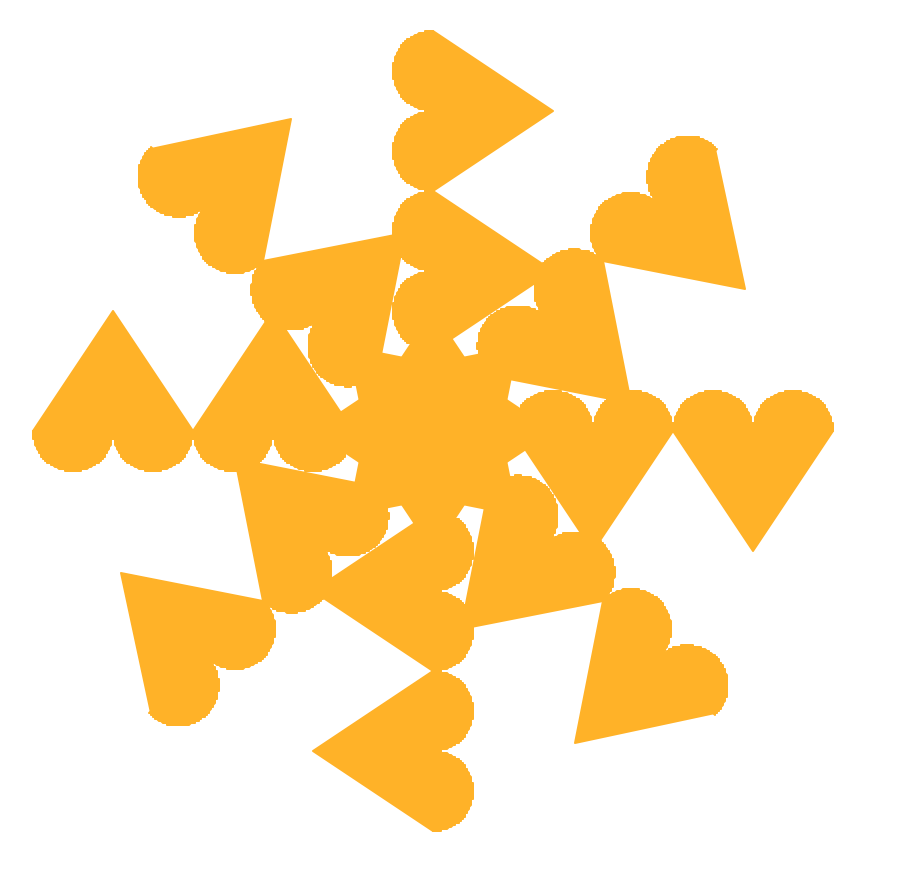
Task 4b: Return a row of FADING hearts recursively Write a function called
fadingHeart(size,color) that
returns a row of decreasing sized hearts that have the color color.
Note that in this task, the recursion is controlled not by an explicit count (as it was
above in heartRow(), but rather by the size of the current heart.
Important notes for your code:
-
Your
fadingHeartfunction will only draw hearts if the size is greater than 10 - Each successive heart is 20% smaller than previous one
- Each heart is moved to the right a fixed distance of 20 from the previous one
fadingHeart(size,color)
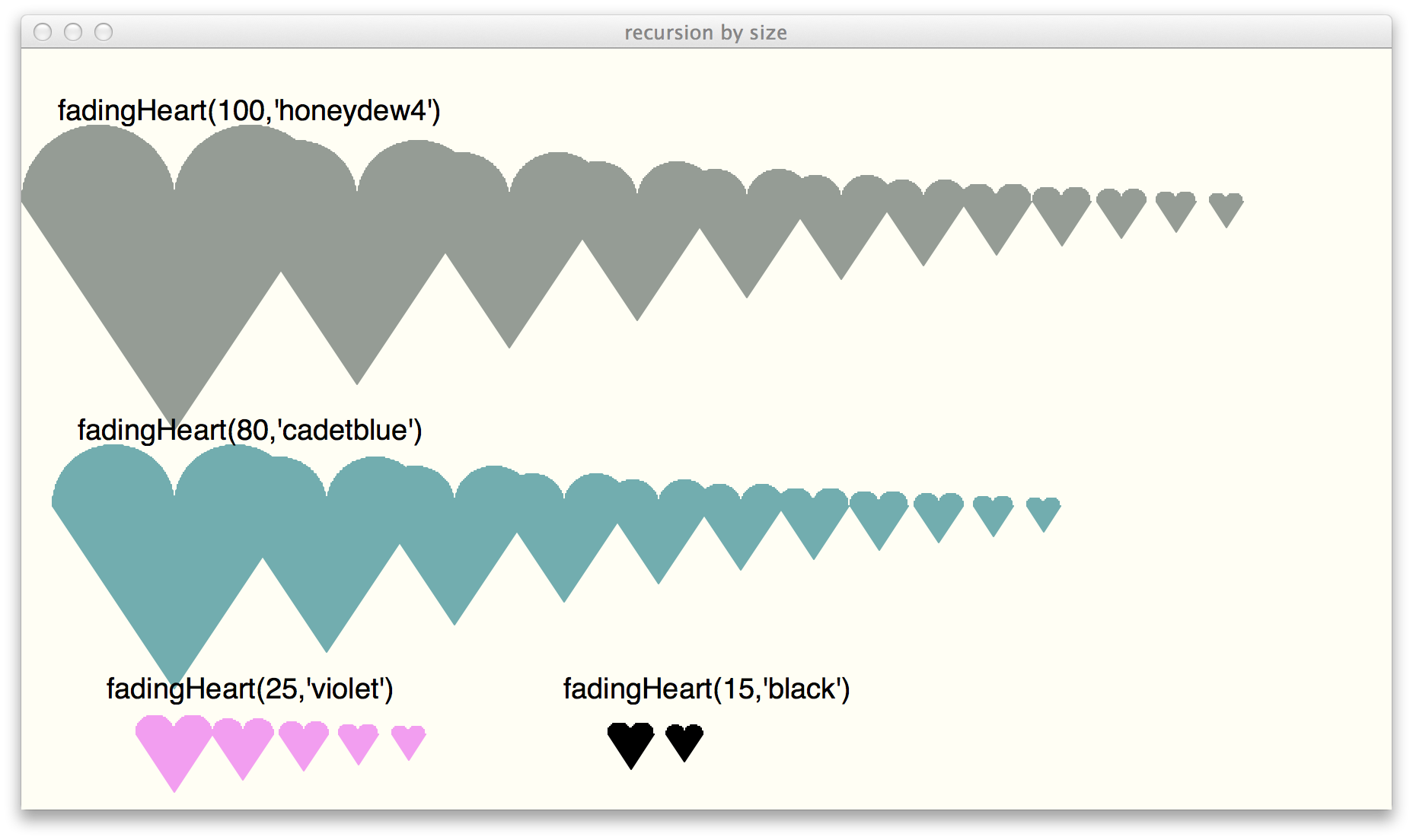
Task 4c: return a row of NESTED hearts recursively Write a function called
nestedHeart(size,color1,color2) that
returns a row of decreasing sized hearts that have alternating color color and
are nested on top of each other.
Important notes for your code:
-
Your
nestedHeartfunction will only draw hearts if the size if greater than 10 - Each successive heart is 20% smaller than previous one
- The hearts must alternate colors between color1 and color2 (otherwise, it is hard to see them, since if they were all the same color they would blend together)
nestedHeart():
paper2 = Canvas(800,500,'white','Nested heart variations') nestH = nestedHeart(200,'red','thistle') paper2.add(nestH) nestH.moveTo(300,200) nestH2 = nestedHeart(35,'lemonchiffon','navy') paper2.add(nestH2) nestH2.moveTo(450,400)
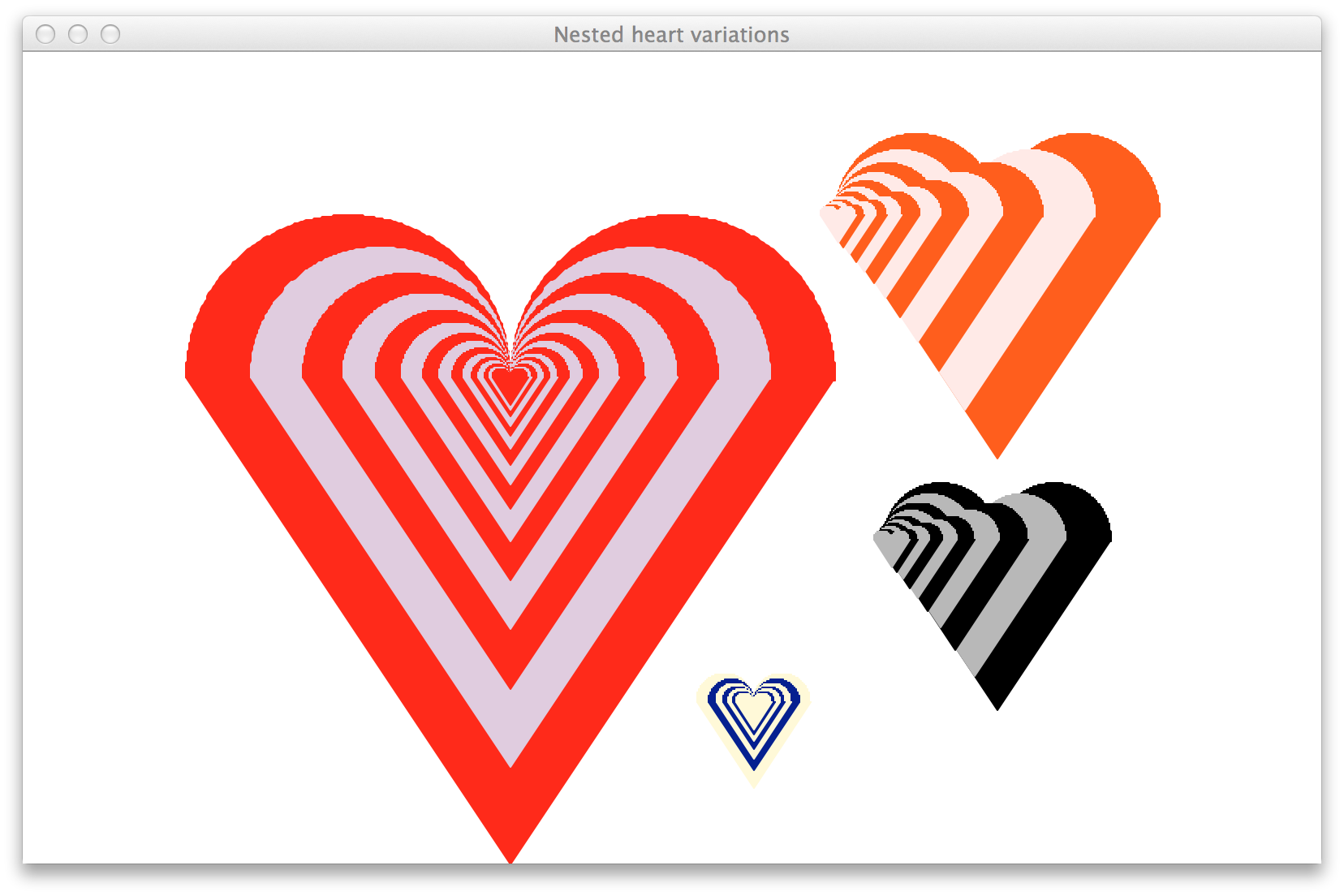
Task 4c extra: count the total number of hearts drawn
nestedHeart() is a fruitful recursive function that
returns a layer containing the nested hearts. Copy
your nestedHeart() function and rename
the new version nestedHeartCount(). Remember
that a python function can return multiple values, and those
values can be different types.
Here are some sample
invocations of nestedHeartCount().
nestH, count = nestedHeartCount(200,'red','thistle') print count # the line above should print 15 nestH2, count2 = nestedHeartCount(35,'lemonchiffon','navy') # the line above should print 7
Task 5: Squares with clipped corners Now we're switching gears and moving to turtle world. Our focus, however, is still on fruitful recursive functions. The fruitful recursive boxes method takes four parameters:
- the length of the largest square
- the shrink factor of the squares drawn at each of the four corners
- the length of an edge of the smallest outer box
- the color of the turtle's pen
. boxes(400, 0.4, 100, 'magenta') produces a total of 5 boxes (1 outer box + 4 nested ones) and a total length of 4160. [4 smaller boxes 160 x 4 = 2560; dimensions of outer box with side length 400 = 1600; 2560 +1600 = 4160].
Several different variations are shown below.
Hints:
- First, write the recursive function to produce the picture
- After that works, then go back and add in the fruitful counting of boxes only
- After the counting of boxes works, add in the fruitful sum of all the lengths drawn
- Remember that a function can return two
values by separating them with a comma like this:
return x, y - As a
corollary, if a fruitful function returns two values, then it can be
called like this:
x, y = boxes(400, 0.30, 50, 'red')
boxes(400, 0.4, 100, 'magenta')
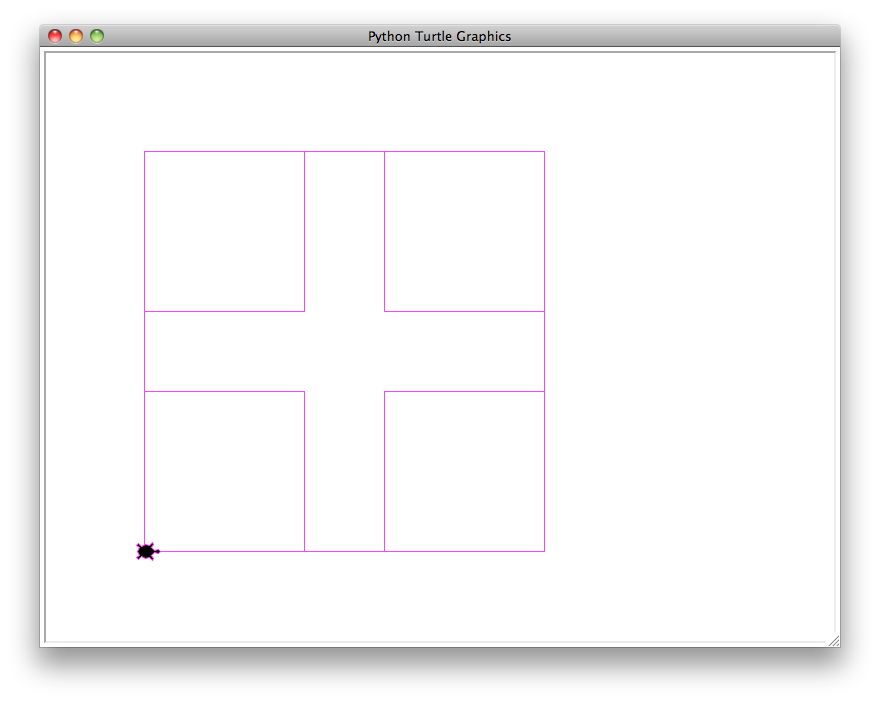 5 boxes, 4160 total length of all boxes |
boxes(400, 0.33, 30, 'magenta')
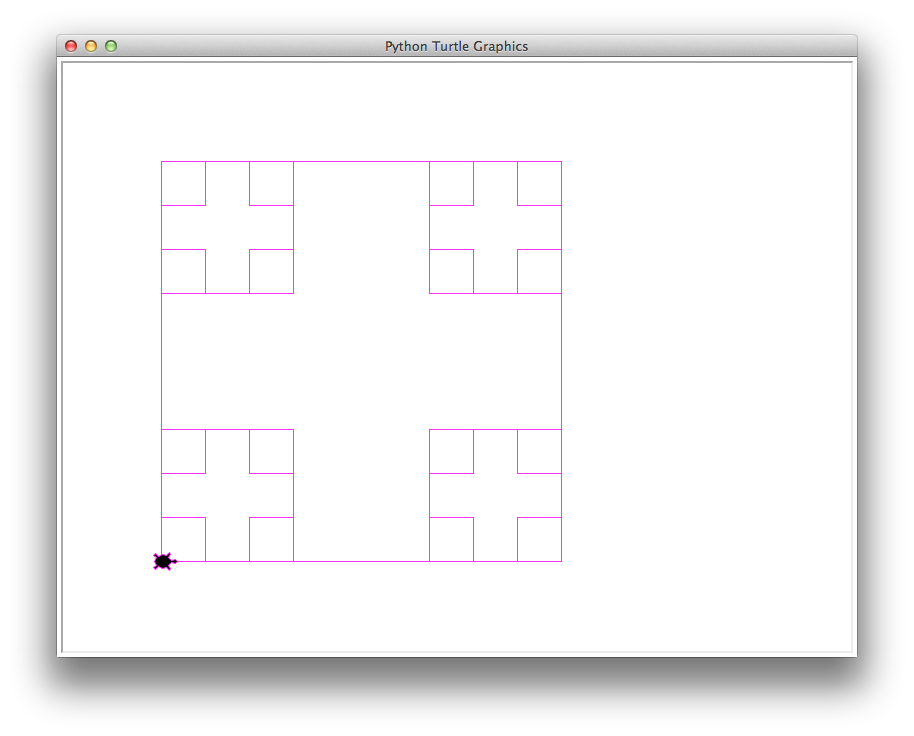 21 boxes, 6499.84 total length of all boxes |
boxes(400, 0.25, 15, 'magenta')
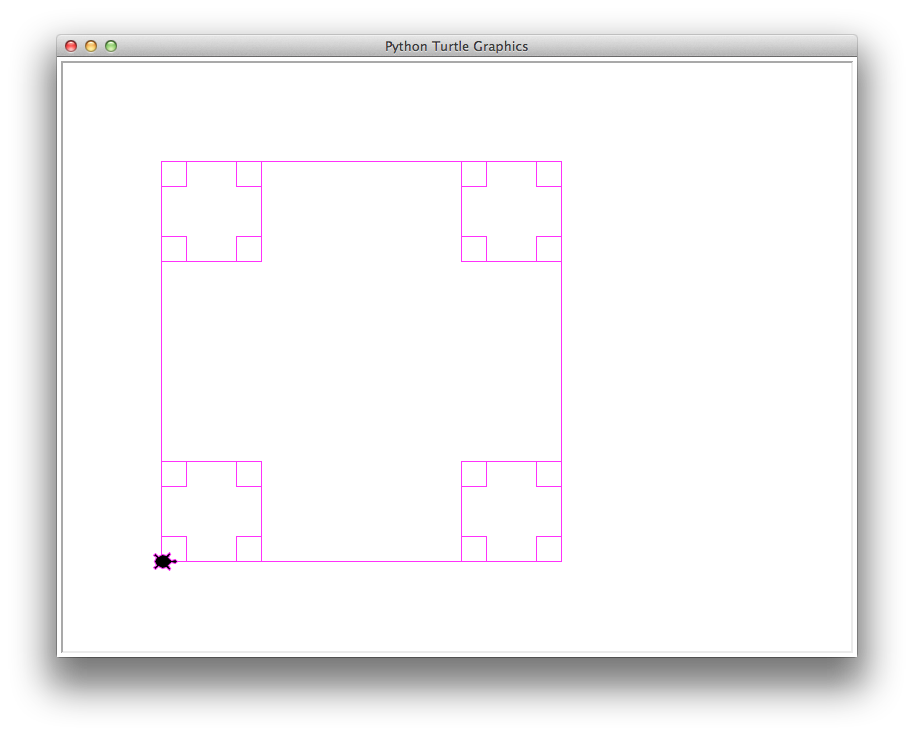 21 boxes, 4800 total length of all boxes |
boxes(400, 0.4, 50, 'magenta')
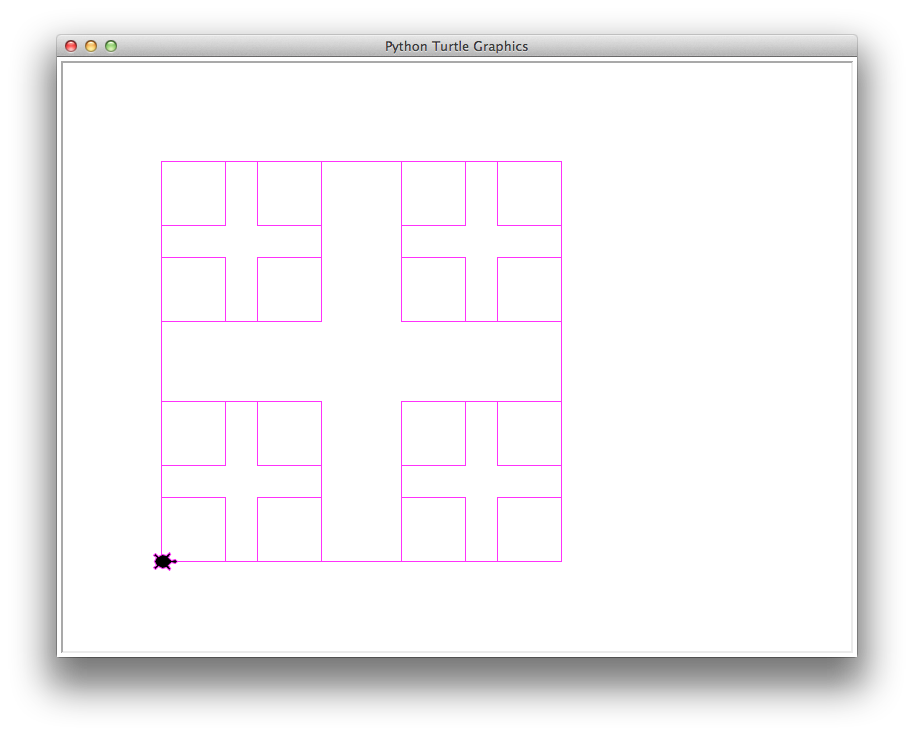 21 boxes, 8256 total length of all boxes |
boxes(400, 0.44, 30, 'magenta')
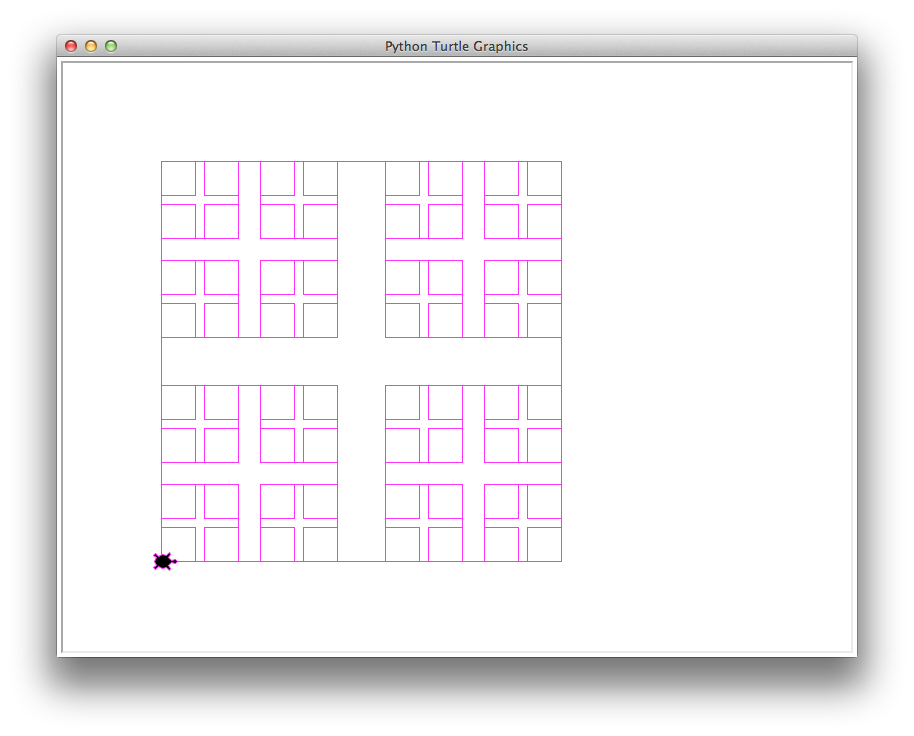 85 boxes and 18095.0016 total length of all boxes |
boxes(400, 0.4, 10, 'magenta')
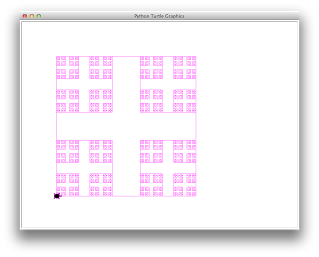 1365 boxes and 42072.576 total length of all boxes |
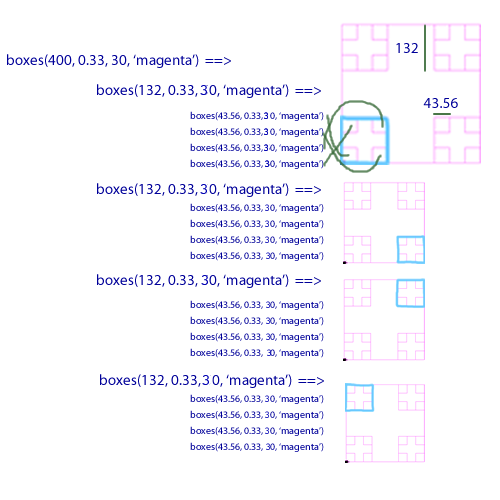
If you still have time, you can experiment with more heart variations in cs1graphics below:
Task 4c extra: skew the hearts to the left Now, after yournestedHeart() works properly, think
about how to create the two images on the right, which have the
nested hearts, but skewed to the left. There is only one line of code
that needs to be added to move each successive nested heart to the
left a distance of 20% of the heart size. Here are the invocations
that created the two hearts on the right in the image above:
# testing nestedLeftHeart
nestL = nestedLeftHeart(100,'orangered1','mistyrose')
paper2.add(nestL)
nestL.moveTo(600,100)
nestL2 = nestedLeftHeart(70,'black','darkgrey')
paper2.add(nestL2)
nestL2.moveTo(600,300)
Experiment with other formulations to create intriguing pictures!
Task 4d: draw a row of blasting off hearts recursively
Now let's create some definitely psychedelic heart images. We'll call these sideHearts since each heart has smaller hearts coming out of its sides.
Important notes for your code:
-
sideHearttakes 3 parameters: the size of the biggest heart and the two alternating colors - the
sideHeartfunction will only draw hearts if the size if greater than 20 - the smaller side hearts are 1/3 the size of the big heart
- the small heart on the left is rotated 135 degrees from the center heart and moved a distance of size vertically and a distance of size horizontally from the center heart
- the small heart on the left is rotated -135 degrees from the center heart and moved a distance of size vertically and a distance of size horizontally from the center heart
- Each successive center heart is 25% smaller than the previous one
- Each triplet of hearts (center heart, smaller left heart, smaller right heart) are the same color
- Successive triplets alternate between color1 and color2
paper3 = Canvas(800,800,'white','sideHearts') sideH = sideHeart(200,'slategray','red') paper3.add(sideH) sideH.moveTo(400,200)
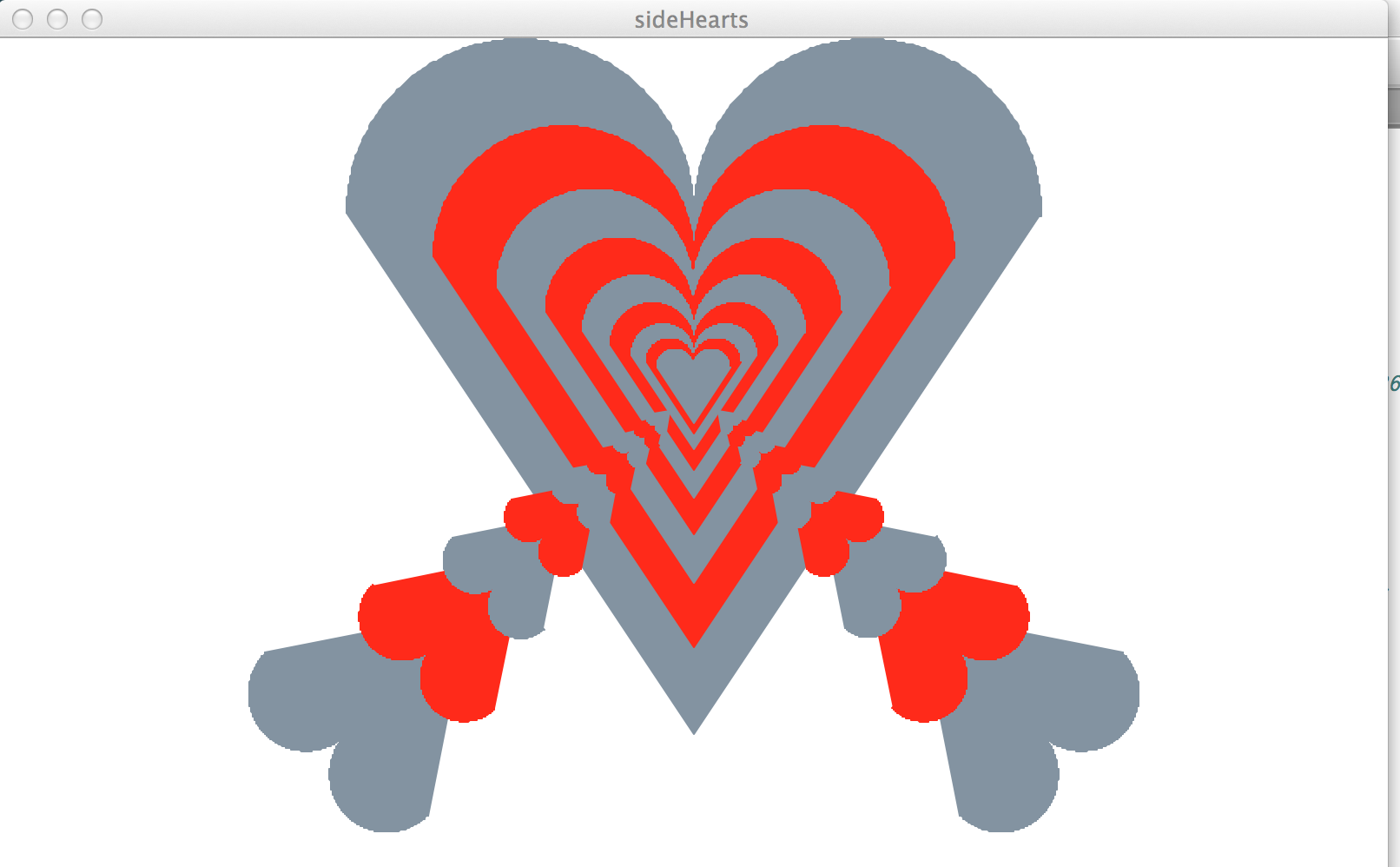
The image below illustrates how the
sideHeart() function
produces drawings with relatively small sizes:
# Generating another sideHeart paper4 = Canvas(800,800,'white','More sideHearts') sideH2 = sideHeart(100,'slategray','yellow') paper4.add(sideH2) sideH2.moveTo(250,200) # 1 heart triplet s1 = sideHeart(25,'navy','darkolivegreen') paper4.add(s1) s1.moveTo(300,400) # 2 heart triplets s2 = sideHeart(30,'navy','darkolivegreen') paper4.add(s2) s2.moveTo(400,400) # 3 heart triplets s3 = sideHeart(40,'navy','darkolivegreen') paper4.add(s3) s3.moveTo(520,400) # 4 heart triplets s4 = sideHeart(50,'navy','darkolivegreen') paper4.add(s4) s4.moveTo(650,400) # 5 heart triplets s5 = sideHeart(70,'navy','darkolivegreen') paper4.add(s5) s5.moveTo(400,550)
